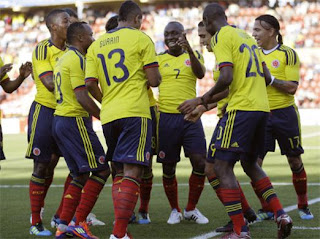 |
| Incredible cable work |
We arrived in La Paz from the lake Titicaca late Sunday afternoon. I was not feeling too well after having eaten "fresh" meat from the market the day before. The
sun was going down and we entered La Paz via Palo Alto, a HUGE slum bigger than
La Paz itself. It was nasty and that was not a good start.
Then we
arrived to our hostel, in the ugliest neighbourhood of the city. Now the
Bolivian capital (the highest Capital city in the world actually) is not
pretty; it’s polluted, overcrowded and the traffic kills any charm that could
be left. And on top of that in the more popular neighbourhoods buildings are badly
maintained and the amount of electric and telephone wires hanging in the open
is scary.
 |
| Llama foetus at the witch market |
 |
| The columbian fans are great |
The best
thing that I did in La Paz was to go to the World Cup qualifier in the National
stadium. Bolivia was entertaining Columbia who never did better than a draw in
La Paz. It’s a privilege for a football fan to experience South American football.
The atmosphere was electric. It reminded me much more of football in Mauritius
when we still had packed stadia and a competitive league (Sunrise, Fire,
Cadets, Scouts, Police etc).
There were
some police and military, vendors inside
the stands proposing all kinds of goodies to the spectators, again like in
Mauritius in the good old days : chicken sandwiches, ice creams and for the
benefit of Mauritian readers: pikisidou, sorbet dilé and calaminedasse! I kid
you not.
The game
was underway and the Columbian team, who flew in just before the game to avoid
altitude related problems, was having a lot of the ball. The game was of
excellent quality and I thought the ref was doing a good job. Many Bolivian
fans did not think this way and they were letting the ref know about it. From
what I could understand it appears the ref’s wife was a tiny three eyed, hairy
leprechaun! Must be the related to the refs in Mauritius! With Brazil
automatically qualified, you can feel the extra tension within smaller nations
like Bolivia who realise they have an extra chance to clinch a direct or a
playoff spot for 2014.
 |
| The Colombians celebrating after their first goal |
The crowd was really behind their team while yelling at the players they felt did not play to national standards. The most common one was hilarious : "Guiterez, pare con empanadas!" which in good Mauritian Creole translates to the classic "Guiterez, arete manz dhol pouri!". I almost fell down laughing.
A Dark spot
was that some of the public were shouting racist abuse at the black Columbian
players. Sadly, this too reminded me of Mauritian football. Two imbeciles in
particular were comparing them to chimpanzees. I turned round to discover that
it was a couple, husband and wife in their 50’s! For a nation that calls itself multiracial
and multiethnic that’s a disgrace. The last comment applies to both Bolivia and
Mauritius…
Oh yeah I
almost forgot … guns. You know how sometimes in South America you hear that a
ref or a player had been shot inside the stadium while on the pitch. I’ve
always wondered how they could smuggle guns inside the ground – I theorised that
they would conceal them in the drums or trumpets they bring in, or they would
bribe a stadium clerk, or even hide one with a kid that accompanies the bad
boys. Well mystery solved! I know how they do it … they
just walk through the gates with it. Oh there are signs posted everywhere
warning people not to bring knifes or firearms inside, but body
searches are non-existant at the entrance. Anyone could bring whatever they wanted inside and
throw at the opposition players, and they did during the game but nothing too
nasty fortunately.
Anyway I
had a great day out and hope I can see more games as we travel around.
 |
| This literally is a zebra crossing |
The next
day we went for the city bus tour. We walked briskly through downtown and
arrived on time at the stop. NO bus … hmmm. After 15 minutes we called the tour
company and they very casually said that they cancelled the morning’s outing.
Great! Half a morning lost.
 |
| Pied Piper of Hamelin ? |
 |
| Enjoying the Japanese food |
We decided
to walk around town for a while until lunch, and we headed to a very nice
Japanese restaurant. The ramen, beef teriyaki and gyosa were excellent. It was
so good that we went there again that evening. This time we had tempura, maki
and other goodies.
We took an
early taxi to the airport. Higher poorer La Paz sits at around 4000m altitude
while the richer nicer neighbourhoods lie 1000m lower. The International
airport is also at about 4050m (13000ft) which makes it one of the highest in
the world. The runway is a staggering
4km long for airplanes to take off safely. At this altitude, the air is less
dense and the jet engines produce less power and thrust. Also the lift is
smaller on the wings, therefore a longer distance is required for the plane to
reach a higher take off speed. If not, well KAPUT!
After these
few days we were happy to leave La Paz for Sucre.
For more pictures :
La Paz

